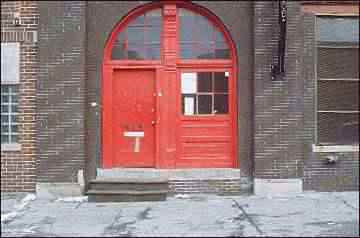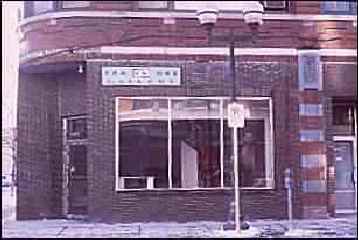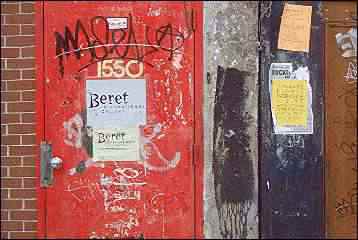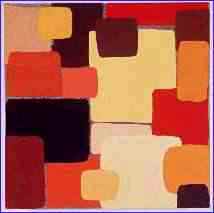![[logo]](./bin/logo.gif) Spaces
Spaces
This is an archive of artists pages, exhibitions, artists' reviews -- all from the Uncomfortable Spaces Galleries in Chicago, between 1991 and 1999. Also a few other pages people have asked to be kept up.
Jump to the [list] below.
The End of Spaces
by O.S. LaCross
from Gravy Magazine Number 8, Summer 2000For nearly ten years the Uncomfortable Spaces galleries presented emerging artists, an emerging aesthetic, and an attitude which made them dominate the press in Chicago. In the mid 90's the four Uncomfortable Spaces galleries regularly collected more reviews -- both locally and nationally -- than all the other galleries in Chicago combined.
The Uncomfortable Spaces consisted originally of MWMWM Gallery, Tough Gallery, Ten in One Gallery, and Beret International Gallery. From 1991 they coordinated publicity, openings, and mailings, and shared a mailing list.
MWMWM originally occupied a space at 12th and Wabash; not an easy place to get to from anywhere in Chicago. But Chris Murray moved to a storefront on Grand a few years later. In 1996 Chris closed his doors and moved to NYC, where he has operated sporadically over the last few years.
The exhibitions at MWMWM ran from artists presenting their dried up towels and collections of lint to an exhibit of empty packing crates. But the shows were reviewed. Some of the MWMWM artists in Chicago continued as CPR (Chicago Project Room) gallery, eventually merging with RX gallery, and then in the summer of 2000 moving to LA, where, as Dan Hug of RX/CPR has noted, "alternative is not a dirty word."

Tough Gallery occupied the basement space of a building owned by proprietor Rich Kelley, on Sangamon between a viaduct and railroad tracks. Easier to get to but harder to find, Tough's invitation cards always included a map. It was a huge high-ceiling angular space, ideal for installations and sculptures. Himself a successful sculptor, Rich Kelley originally just wanted to offer the space to other artists.
Tough's exhibits were regularly reviewed in national magazines. One of the most spectacular was Jo Hormuth's casts of twisted balloon animal shapes [1995], many as animated male organs.
In the beginning of 1999, Rich, under pressure of work and family, closed his doors. A few shows were held subsequently by volunteer organizers, but soon faded.
Ten in One started as a collective on Grand Avenue near Racine. One of the strangest shows at that location involved cutting away the floor of the gallery to reveal a map of the United States in the basement, made entirely of mildewing cheese. Ten in One's exhibits on Grand tended to be lively affairs with bands and $20 beer money donations by the artists.

Ten in One relocated to Ohio Street just east of Ashland Avenue, under the auspices of Joel Lieb. The shows evolved to a more subdued aesthetic -- no longer presenting things like Mike Slattery's model airplanes buzzing around the gallery space. In 1994 Joel moved Ten in One to the space adjacent to the Busy Bee restaurant on Damen next to the L station.
At about the same time Ned Schwartz moved his Beret International Gallery from a third floor location of the Fome Board Building on Elston to Milwaukee Avenue, around the corner from Ten in One. Beret always had the largest gallery space and the longest hours during opening nights, so that the crowd visiting any of the other galleries would restart festivities at Beret around 10 pm.
The space on Elston Avenue went through constant changes in layout as Ned juggled rental and leased spaces with exhibition space. At one time or another there were storage spaces completely surrounded by exhibition space, as well as other galleries of sorts, like Mike's museum [Mike Lash].
Exhibiting at Beret while on Elson always presented logistics problems -- not for group shows where single entries could just be walked up three flights of stairs, but one-person shows required capturing the freight elevator by forcing open the elevator doors and climbing down the elevator shaft to commandeer the elevator parked on the second floor.

Ned had a well informed but maniacally modernist point of view toward high art and the established gallery system. Beret's group exhibitions invariable revolved around some twisted concept of what the gallery art system was all about. An open call would result in work representing both sides of the twist in irony, some artists fully understanding what was happening, many totally unaware of what they were walking into. The "Sentimental Show" comes to mind as an example, with Sony Venice's brick wrapped with the note, "I did too mean it."
"Objects Stolen From the Cars in the Art Expo 93 Parking Lot" ("Funny / Not Funny") had a full audience of Art Expo patrons and dealers looking for missing items. The most visually disappointing but apropos exhibit was probably "Surprise, Surprise, Surprise," where all the submitted art work was wrapped in plain brown paper and auctioned off on the basis of artists' names.
The occasional meta-exhibitions continued on Milwaukee Avenue, "Beret's Greatest Hits, Part II" (there never was a "Part I"), followed by the widely attended "I Paid $25 To Exhibit My Art in This Show," which included a catalog of images of all the works, albeit hand sketched in abbreviated form.
In late spring of 1998 Ned cut up the space on Milwaukee Avenue to allow for additional rental. The remaining rhomboid shaped exhibition space was lined with plywood backed plasterboard walls, and track lighting was installed to replace the 200 extension cords and clamp-on lamps which usually lighted the space. But with that the large space that had been Beret was gone, at openings the beer drinkers moved to the back room, and attendance started to drop.
Meanwhile Joel Lieb of Ten in One was complaining about rents and changes in ownership of the Busy Bee, and all year during 1998 Joel threatened to vacate and move to New York. In June of 1999 he did just that.
At the end of the spring season of 2000 Ned also capitulated to the demands of family, a job, and a house in a distant suburb, and Beret International, the last of the Uncomfortable Spaces, closed its doors.
What had been accomplished in ten years? Other galleries -- many of which only reluctantly accept being called "alternative" -- have filled the void left by the Uncomfortable Spaces: Body Builder, Suitable, Temporary Services, Law Office, Butcher Shop, TBA. Many of these will readily admit that the Uncomfortable Spaces galleries paved the way for their non-representational aesthetic, the intent driven art, the validation of new work, and the showcasing of local talent.
The mainstream galleries in Chicago mostly still adhere to 19th century tastes, they inventory and push paintings as collectable objects, and keep tight control over their stable of artists. "Cutting-edge" is not one of their flavors. Similarly, museums in Chicago never feature local artists unless already nationally established, and the university galleries continue to be obligated to their academic constituency.
The Uncomfortable Spaces showed artists from NY, from LA, and occasionally from Europe, but mostly they exhibited local artists, both young upstarts as well as established artists. In the early and mid 90's the artists put forward by the Uncomfortable Spaces galleries came as a revelation to critics. By the end of the decade this was less true, as the galleries started to rotate through their lists of regulars.
The only other venues for new art in Chicago during the 90's were Randolph Street, NAME, and Artemisia. All three of these suffered from the collective aesthetic of committees. Randolph Street often presented the most interesting and cutting-edge shows, but always felt obligated to showcase work from out of town.
Randolph Street and NAME both folded during this decade, both for financial reasons. Artemisia continues today with large amalgam exhibitions, and remains in the black because of hefty exhibition fees. The Uncomfortable Spaces galleries, in contrast, were entirely financed by their owners, although at a loss. But this also allowed them their dictatorial curatorial style.

For artists "art" remains defined as the critique of representation. The proprietors of the Uncomfortable spaces understood this; the museums and established commercial galleries do not, and are under no obligation to aid the development of art or support as yet unproven artists; "new" is not on their menu.
What the Uncomfortable Spaces galleries demonstrated was that there was room for well conceived local art, experimental work, work on the edges of what is defined as art, and work which deals with art at its genesis.
The coordination of mailings and openings which was the cornerstone of the Uncomfortable Spaces organization proved handy for a while, but did not in itself constitute a definitive flavor. It was the radically informed aesthetic of the four owners which had the most effect, although all different. Tough's shows were likely to be minimalist space fillers. Ten in One tended toward what Joel Lieb at one time jokingly characterized as "an eclectic decorative aesthetic." Beret often veered toward radical interpretations by cranks and gear heads.
When the work sold, it was most often to other artists. When the work was good, the critics wrote about it -- vociferously. Rebecca Morris' exhibition of paintings at Ten in One [April 1998], done in the flavors of common products and franchises, appeared on the covers of 4 magazines in one month.
This is a partial listing of works of artists who have exhibited at the Uncomfortable Spaces galleries in Chicago (Beret International, Ten In One, Tough, and MWMWM). Materials include images, statements, resumes, and links to home-pages. In alphabetical order, mostly.
 Walter Andersons ["Moreover the Same"]
Walter Andersons ["Moreover the Same"]
 Jesse Bercowetz ["Stall Writings"] ["Sleep
Late"] and see [buff.htm] and [overcoat.htm] also.
Jesse Bercowetz ["Stall Writings"] ["Sleep
Late"] and see [buff.htm] and [overcoat.htm] also.
 Stephany Brooks ["Last Name First"]
Stephany Brooks ["Last Name First"]
 Jno Cook [Website]
Jno Cook [Website]
 David Deany [Exhibition]
David Deany [Exhibition]
 Carol Jackson ["The Adventure Store"]
Carol Jackson ["The Adventure Store"]
 Marc Alan Jacobs [Website]
Marc Alan Jacobs [Website]
 Dennis Kowalski [Sculpture]
Dennis Kowalski [Sculpture]
 Rebecca Morris [Paintings]
Rebecca Morris [Paintings]
 Adelheid Mers
[Website]
Adelheid Mers
[Website]
 Patric Mcgee
[Website]
Patric Mcgee
[Website]
 Aimee Mower ["Sleep Late"]
Aimee Mower ["Sleep Late"]
 "I Paid $25 to Exhibit My
Art in this Show" [93 artists]
"I Paid $25 to Exhibit My
Art in this Show" [93 artists]
 Alison Ruttan [Photography]
Alison Ruttan [Photography]
 Mike Slattery ["Vagabond"]
Mike Slattery ["Vagabond"]
 John Spear [Exhibition]
John Spear [Exhibition]
 Charles Wiesen [Installation]
Charles Wiesen [Installation]
More: [kass.htm] [klehr.htm] [mollura.htm] [the Posted show] [rosen.htm] [savage.htm] [scott.htm] [turl.htm]
Reviews of the artists: [reviews.htm]
Reviews of the galleries: [spaces.htm]
After some moves to NYC: [newyork.htm]
![[kees]](./bin/yraw.jpg) The Unofficial Uncomfortable Spaces Website
The Unofficial Uncomfortable Spaces Website